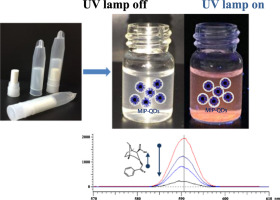Talanta ( IF 6.1 ) Pub Date : 2018-01-09 , DOI: 10.1016/j.talanta.2018.01.017 María Pilar Chantada–Vázquez , Carolina de–Becerra–Sánchez , Alba Fernández–del–Río , Juan Sánchez–González , Ana María Bermejo , Pilar Bermejo–Barrera , Antonio Moreda–Piñeiro

|
A molecularly imprinted polymer – Mn-doped ZnS quantum dot-based fluorescence probe for cocaine abuse screening has been prepared and applied to complex samples such as serum and oral fluid. The fluorescent sensing material was prepared by anchoring a selective MIP for COC on the surface of polyethylene glycol (PEG) modified Mn-doped ZnS quantum dots (QDs). Simple and low cost methods have thus been optimized for assessing cocaine abuse in serum and oral fluid by monitoring fluorescence quenching when cocaine (COC) is present (optimized operating conditions with 1.5 mL of 200 mg L-1 MIP-coated QDs solution, pH 5.5, and 15 min before fluorescence scanning). The matrix effect was found to be important when analyzing oral fluid and serum, and several strategies based on centrifugation for oral fluid and solid phase extraction (SPE) for serum were explored. Two analytical methods were developed for oral fluid. The first one (direct method) requires a centrifugation step (6 °C, 4000 rpm, 20 min) to avoid the matrix effect, and allows for cocaine determination by using an aqueous calibration (1:20 dilution). The second method was developed for oral fluid sampled by Salivette devices, and also requires a further centrifugation (6 °C, 4000 rpm, 20 min) of the recovered oral fluid. This method, however, requires the standard addition technique (1:20 dilution) because of the existence of the matrix effect. Regarding serum samples, a direct method (serum dilution) was not possible, and an SPE procedure was needed to avoid the matrix effect (use of aqueous calibration). The limits of detection and quantification when using the Salivette method were 0.035 mg L-1and 0.117 mg L-1, respectively; whereas, 0.015 mg L-1 (LOD) and 0.050 mg L-1 (LOQ) were obtained for serum.
中文翻译:

分子印迹聚合物–锰掺杂的ZnS量子点荧光光敏技术在口腔液和血清中可卡因筛选的开发与应用
已经制备了分子印迹聚合物–锰掺杂的ZnS量子点基荧光探针,用于可卡因滥用筛查,并已应用于复杂的样品,例如血清和口腔液。通过将用于COC的选择性MIP锚定在聚乙二醇(PEG)修饰的Mn掺杂的ZnS量子点(QDs)表面上来制备荧光传感材料。因此,简单而低成本的方法已经过优化,可通过监测存在可卡因(COC)时的荧光猝灭来评估血清和口腔液中可卡因的滥用(最佳操作条件为1.5 mL 200 mg L -1涂有MIP的QDs溶液,pH 5.5,荧光扫描前15分钟。发现基质效应在分析口腔液和血清时很重要,并探索了几种基于离心的口服液和固相萃取(SPE)血清的策略。针对口腔液开发了两种分析方法。第一个方法(直接方法)需要离心步骤(6°C,4000 rpm,20分钟)以避免基质效应,并允许使用水校准(1:20稀释)进行可卡因测定。开发了第二种方法用于Salivette采样的口腔液装置,并且还需要对回收的口腔液进行进一步离心(6°C,4000 rpm,20分钟)。但是,由于存在基质效应,因此该方法需要标准添加技术(1:20稀释)。对于血清样品,不可能采用直接方法(血清稀释),并且需要SPE程序以避免基质效应(使用水相校准)。使用Salivette方法的检测限和定量限分别为0.035 mg L -1和0.117 mg L -1。血清分别为0.015 mg L -1(LOD)和0.050 mg L -1(LOQ)。



























 京公网安备 11010802027423号
京公网安备 11010802027423号